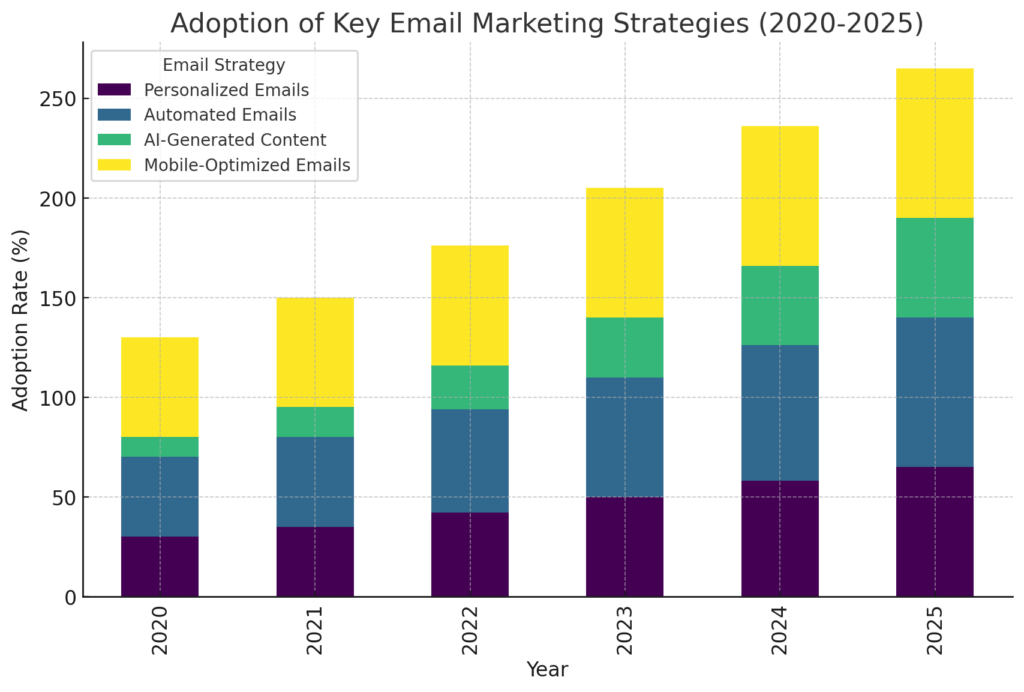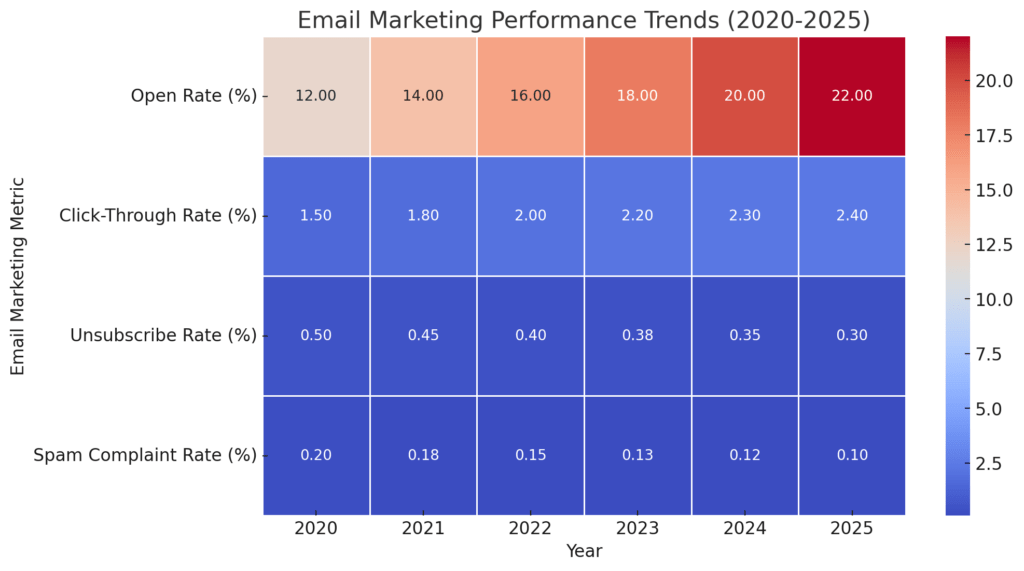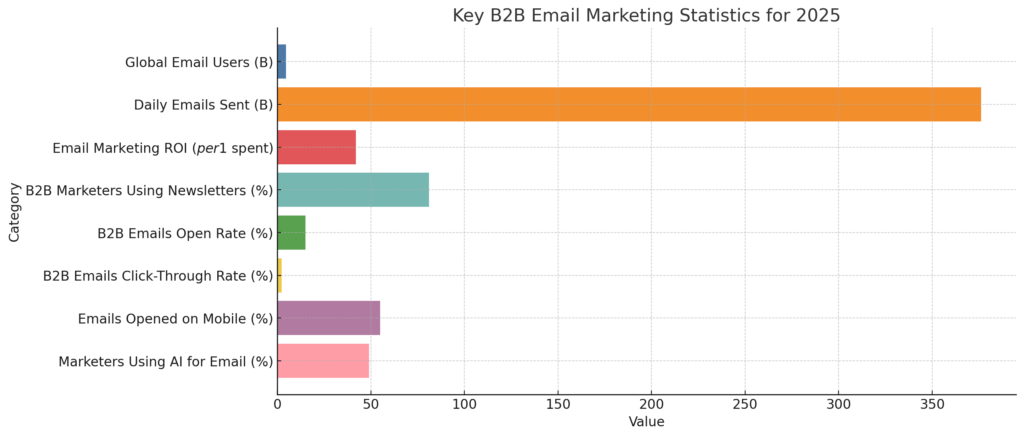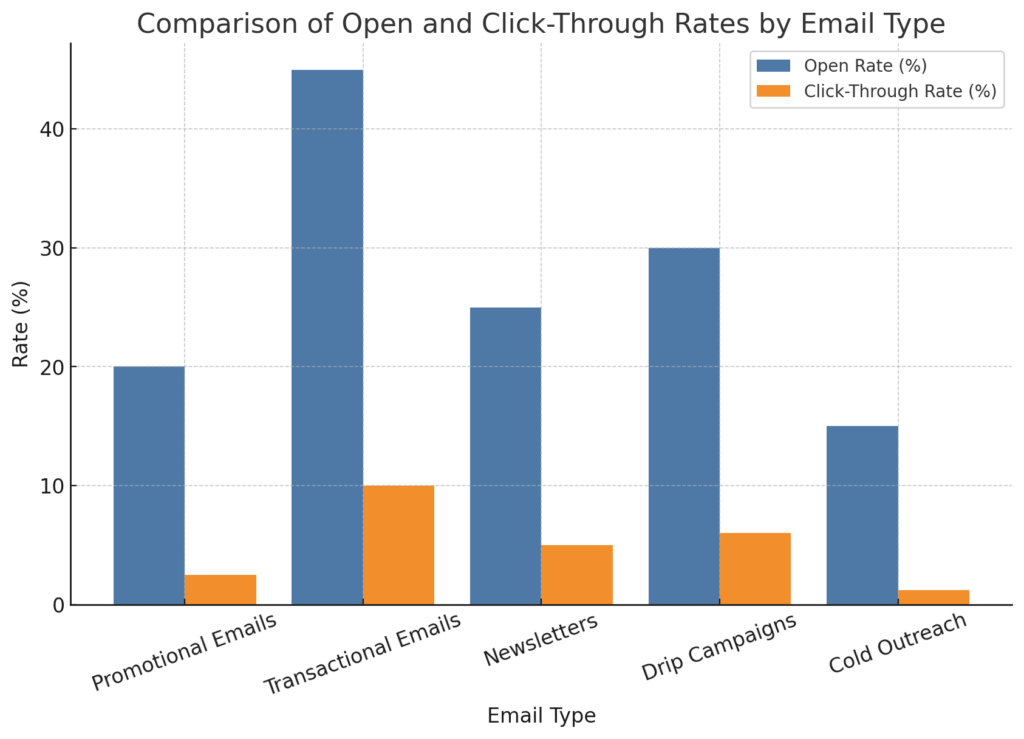
18 Mar BEST B2B EMAIL MARKETING STATISTICS 2025
Email marketing remains one of the most effective channels for B2B businesses, but its landscape continues to evolve with changing technology and consumer behavior. As companies refine their strategies, data-driven insights become essential for maximizing engagement, conversions, and long-term customer relationships. The latest statistics reveal emerging trends in email automation, personalization, mobile optimization, and AI-driven content creation—highlighting both opportunities and challenges for marketers. With inboxes more crowded than ever, businesses must adopt smarter segmentation, compelling messaging, and strategic timing to stand out. These insights not only reflect current industry performance but also provide a roadmap for future success. Understanding how these trends shape the effectiveness of email campaigns will help companies refine their approach and maintain strong engagement. Amra and Elma explores the most impactful B2B email marketing statistics and their implications for 2025 and beyond.
BEST B2B EMAIL MARKETING STATISTICS 2025 (Editor’s Choice)
Here are 20 key B2B email marketing statistics, reflecting general trends over time and projections for 2025:
1. Global Email Users: The number of email users worldwide is projected to reach approximately 4.6 billion by 2025, up from 4 billion in 2020.
2. Daily Email Traffic: By 2025, over 376 billion emails are expected to be sent and received daily, an increase from 306 billion in 2020.
3. Email Marketing Revenue: Global revenue from email marketing is anticipated to reach nearly $14 billion by 2025, up from $7.5 billion in 2020.
4. B2B Marketers Using Email Newsletters: 81% of B2B marketers utilize email newsletters as their primary content marketing strategy.
5. Email as a Revenue Driver: 59% of B2B marketers identify email as their most effective channel for revenue generation.
6. Preferred Communication Channel: 77% of B2B buyers prefer to be contacted through email over other communication channels.
7. Average Open Rate: The average open rate for B2B marketing emails is approximately 15%.
8. Average Click-Through Rate (CTR): B2B emails have an average CTR of 2.4%.
9. Email Personalization: Personalized email campaigns result in a 46% higher open rate and a 50% higher CTR compared to non-personalized campaigns.
10. Mobile Email Open Rates: Approximately 55% of emails are opened on mobile devices, emphasizing the importance of mobile-friendly designs.
11. Email Automation Adoption: 57% of B2B marketers are utilizing AI for their email campaigns.
12. AI in Email Content Creation: 49% of email marketers use AI to assist in content creation.
13. Email Marketing ROI: On average, email marketing generates a return on investment (ROI) of $42 for every $1 spent.
14. Segmentation and Targeting: Segmented and targeted emails account for 58% of all revenue, highlighting the effectiveness of tailored content.
15. Impact of Subject Lines: 47% of email recipients open emails based solely on the subject line.
16. Email Deliverability Challenges: Almost 50% of all emails are sent to spam, with 14.3% going directly to the spam folder.
17. Email Engagement Timing: The best days for email opens and clicks are Tuesday and Wednesday.
18. Consumer Behavior: 59% of consumers say marketing emails influence their purchase decisions, with over 50% making purchases from emails at least once a month.
19. Email Frequency Preferences: 44% of consumers will unsubscribe if they feel they are receiving too many emails.
20. Mobile Optimization: 42% of people will delete emails that are not properly optimized for mobile devices.
These statistics underscore the enduring significance of email marketing in the B2B sector and highlight areas where marketers can optimize their strategies for 2025 and beyond.

BEST B2B EMAIL MARKETING STATISTICS 2025 and Future Implications
BEST B2B EMAIL MARKETING STATISTICS 2025 #1. Global Email Users:
The projected increase in global email users to 4.6 billion by 2025 underscores email’s enduring relevance as a communication channel. This growth signifies a broader audience reach for businesses, enhancing opportunities for customer engagement. As the digital landscape evolves, integrating email marketing with emerging technologies like AI and automation will be crucial. This integration can lead to more personalized and efficient campaigns, aligning with the preferences of a digitally savvy audience. Businesses should also consider mobile optimization, given the widespread use of smartphones for email access. Furthermore, understanding regional differences in email usage can help tailor strategies to specific markets. Overall, the expanding user base presents both opportunities and challenges that require adaptive strategies.
BEST B2B EMAIL MARKETING STATISTICS 2025 #2. Daily Email Traffic:
The anticipated surge to over 376 billion daily emails by 2025 highlights the escalating volume of digital correspondence. For marketers, this means increased competition for attention in crowded inboxes. To stand out, crafting compelling subject lines and delivering valuable content becomes imperative. Implementing advanced segmentation and personalization strategies can enhance engagement rates. Additionally, optimizing send times based on user behavior analytics can improve open rates. As inboxes become more cluttered, maintaining relevance through targeted messaging will be key to retaining audience interest. This environment challenges marketers to innovate continually to capture and maintain subscriber attention.
BEST B2B EMAIL MARKETING STATISTICS 2025 #3. Email Marketing Revenue:
The projection of global email marketing revenue reaching $17.9 billion by 2027 reflects its effectiveness in driving business growth. This substantial market size indicates that businesses continue to invest heavily in email marketing strategies. To capitalize on this trend, companies should focus on creating data-driven campaigns that resonate with their target audiences. Leveraging analytics to measure campaign performance can lead to continuous improvement. Furthermore, integrating email marketing with other digital channels can create a cohesive customer journey. As the market grows, staying abreast of technological advancements will be essential for maintaining a competitive edge. This growth trajectory underscores the importance of email as a cornerstone in digital marketing strategies.
BEST B2B EMAIL MARKETING STATISTICS 2025 #4. B2B Marketers Using Email Newsletters:
With 81% of B2B marketers utilizing email newsletters as a primary content marketing strategy, it’s evident that newsletters are vital for nurturing client relationships. This approach allows for regular dissemination of industry insights, company updates, and valuable resources. To enhance effectiveness, newsletters should be tailored to address the specific needs and interests of the audience. Incorporating interactive elements like surveys or polls can boost engagement. Additionally, ensuring mobile-friendly designs is crucial, given the prevalence of mobile email access. Analyzing engagement metrics can provide insights into content preferences, allowing for continuous refinement. Overall, newsletters remain a powerful tool for maintaining ongoing communication with B2B clients.
BEST B2B EMAIL MARKETING STATISTICS 2025 #5. Email as a Revenue Driver:
The fact that 59% of B2B marketers identify email as their most effective revenue-generating channel highlights its critical role in business strategies. This underscores the importance of developing targeted email campaigns that drive conversions. Utilizing customer segmentation can ensure messages are relevant to each recipient. Incorporating clear calls-to-action and personalized product recommendations can enhance conversion rates. Regularly testing different email elements, such as subject lines and content formats, can lead to continuous optimization. As competition intensifies, focusing on delivering value through email can differentiate a brand from its competitors. This statistic reinforces the necessity of a robust email marketing strategy in achieving revenue goals.

BEST B2B EMAIL MARKETING STATISTICS 2025 #6. Preferred Communication Channel:
The fact that 77% of B2B buyers prefer email as their primary communication channel highlights the importance of maintaining a strong email presence. Unlike social media or direct calls, emails provide a non-intrusive yet effective way to nurture business relationships. To maintain engagement, businesses should focus on delivering value rather than overwhelming recipients with promotional content. Segmenting audiences based on their role or industry ensures that messaging remains relevant and impactful. As B2B decision-making cycles can be lengthy, a well-structured email sequence can keep prospects engaged over time. Integrating email marketing with CRM systems allows businesses to track interactions and optimize future communications. The growing preference for email means companies must continuously refine their approach to maintain high engagement levels.
BEST B2B EMAIL MARKETING STATISTICS 2025 #7. Average Open Rate:
The average open rate of 15% for B2B emails emphasizes the challenge of cutting through inbox clutter. Subject lines play a crucial role in determining whether an email gets opened or ignored. A/B testing different subject lines can help identify what resonates best with specific audiences. Additionally, personalization—such as using the recipient’s name or referencing previous interactions—can significantly boost open rates. Optimizing the sender name to be recognizable and trustworthy also increases the likelihood of emails being opened. The time and day of email delivery matter, with midweek mornings often yielding the best results. As email fatigue rises, businesses should focus on delivering high-value content that aligns with recipient expectations.
BEST B2B EMAIL MARKETING STATISTICS 2025 #8. Average Click-Through Rate (CTR):
A 2.4% average CTR in B2B email marketing indicates that while emails are being opened, engaging recipients enough to take action remains a challenge. Creating clear, compelling CTAs is critical to improving this metric. The positioning and design of CTAs within an email can significantly impact click rates. Providing concise, benefit-driven messaging encourages recipients to explore further. Interactive content, such as videos, surveys, or clickable infographics, can also increase engagement. Email marketers should track which types of content generate the highest CTR and refine their approach accordingly. Moving forward, AI-driven personalization may help boost CTR by tailoring content to individual preferences.
BEST B2B EMAIL MARKETING STATISTICS 2025 #9. Email Personalization:
Personalized email campaigns generating a 46% higher open rate and 50% higher CTR highlights the growing demand for tailored content. Recipients are more likely to engage with emails that feel relevant to their needs. Using dynamic content blocks that change based on user data—such as location, past purchases, or browsing history—can enhance personalization efforts. AI-driven segmentation allows businesses to send hyper-targeted emails at scale. Behavioral triggers, like abandoned cart emails or post-webinar follow-ups, can further increase engagement. However, businesses must strike a balance between personalization and privacy, ensuring that data usage remains transparent and ethical. Moving forward, personalization will likely become even more sophisticated as AI technology advances.
BEST B2B EMAIL MARKETING STATISTICS 2025 #10. Mobile Email Open Rates:
With 55% of emails being opened on mobile devices, optimizing emails for mobile viewing is no longer optional. Responsive email design ensures that content displays correctly across different screen sizes. Shorter subject lines and preheader text can help capture attention on smaller screens. Large, tappable buttons improve usability and encourage clicks. Emails with excessive text or poor formatting risk being ignored or deleted. Businesses should regularly test emails across devices to ensure a seamless experience. As mobile usage continues to grow, companies that fail to adapt their email marketing for mobile risk losing engagement.

BEST B2B EMAIL MARKETING STATISTICS 2025 #11. Email Automation Adoption:
The fact that 57% of B2B marketers now use AI-driven automation in their email strategies reflects a shift toward efficiency. Automated workflows enable businesses to send timely, relevant messages without manual intervention. Drip campaigns can nurture leads by delivering content at strategic intervals. AI-powered analytics can predict the best times to send emails and optimize engagement. Automated segmentation ensures that recipients receive personalized content suited to their behavior. Businesses that fail to implement automation risk falling behind competitors that leverage AI-driven efficiencies. In the future, email automation will likely become even more sophisticated, enabling hyper-personalized customer journeys.
BEST B2B EMAIL MARKETING STATISTICS 2025 #12. AI in Email Content Creation:
With 49% of marketers using AI to generate email content, artificial intelligence is rapidly transforming how businesses communicate. AI can analyze vast datasets to determine which types of messaging perform best. Automated copywriting tools can generate subject lines and body text that align with recipient preferences. AI-driven personalization ensures that emails feel customized without requiring manual effort. While AI enhances efficiency, businesses must maintain a human touch to avoid robotic or generic messaging. The future will likely see AI taking on an even greater role in crafting hyper-targeted emails. However, companies must also be mindful of AI-generated content’s ethical and branding implications.
BEST B2B EMAIL MARKETING STATISTICS 2025 #13. Email Marketing ROI:
The fact that email marketing delivers an average ROI of $42 for every $1 spent underscores its cost-effectiveness. Compared to paid advertising or social media marketing, email remains a high-value investment. Businesses can further improve ROI by refining segmentation and personalization efforts. High-quality, targeted lists tend to perform better than broad, unrefined campaigns. Leveraging automation and AI can reduce costs while improving efficiency. Companies should continuously test and optimize their email strategies to maintain strong ROI. As competition increases, maintaining relevance and engagement will be key to sustaining high returns.
BEST B2B EMAIL MARKETING STATISTICS 2025 #14. Segmentation and Targeting:
With segmented and targeted emails driving 58% of all email revenue, businesses must prioritize audience segmentation. Generic email blasts often yield lower engagement and higher unsubscribe rates. AI and machine learning can enhance segmentation by analyzing behavioral and demographic data. Businesses can create dynamic audience segments based on factors such as purchase history, engagement level, or industry. Hyper-personalized content increases the likelihood of conversions and long-term customer retention. Moving forward, real-time segmentation will become more advanced, enabling businesses to adapt messaging dynamically. Companies that fail to implement sophisticated segmentation strategies may struggle to compete.
BEST B2B EMAIL MARKETING STATISTICS 2025 #15. Impact of Subject Lines:
Since 47% of recipients decide to open emails based on the subject line alone, crafting compelling subject lines is essential. Subject lines should be clear, concise, and create a sense of urgency or curiosity. Emojis, numbers, and personalization can help boost open rates. A/B testing different subject lines provides insights into what resonates with audiences. Avoiding spam-triggering words ensures that emails reach the inbox rather than being filtered out. Preheader text also plays a supporting role, reinforcing the subject line’s message. As inboxes become more crowded, subject line optimization will remain a crucial factor in email success.

BEST B2B EMAIL MARKETING STATISTICS 2025 #16. Email Deliverability Challenges:
With nearly 50% of emails landing in spam and 14.3% going directly to spam folders, ensuring deliverability is a major concern. Using authenticated sending domains (SPF, DKIM, DMARC) improves email credibility. Maintaining a clean email list by removing inactive or invalid addresses helps avoid spam traps. Avoiding overly promotional or misleading language reduces the risk of emails being flagged. Encouraging recipients to whitelist emails can improve inbox placement rates. As spam filters become more advanced, businesses must continually refine their strategies to maintain high deliverability. In the future, AI-powered spam filters may require even greater attention to email reputation management.
BEST B2B EMAIL MARKETING STATISTICS 2025 #17. Email Engagement Timing:
Since Tuesday and Wednesday have been identified as the best days for email opens and clicks, timing remains a critical factor in campaign success. Understanding recipient behavior allows businesses to schedule emails when engagement is highest. AI-driven analytics can further refine send times based on individual user habits. However, as more marketers adopt these best practices, competition in inboxes during peak days may intensify. Testing alternative days and times could uncover untapped opportunities for engagement. Future advancements in predictive analytics may enable real-time email delivery optimization based on when a user is most likely to open an email. Companies that stay adaptable with their send schedules will maintain an advantage in reaching audiences at the right moment.
BEST B2B EMAIL MARKETING STATISTICS 2025 #18. Consumer Behavior and Purchase Decisions:
With 59% of consumers stating that marketing emails influence their purchase decisions, businesses must craft compelling and persuasive messaging. Providing personalized recommendations, exclusive discounts, and limited-time offers can nudge recipients toward conversion. Emails that align with a recipient’s previous interactions or expressed interests perform significantly better. Storytelling and case studies can build trust and strengthen brand relationships. However, excessive promotional emails may lead to fatigue, increasing the likelihood of unsubscribes. Moving forward, AI will play a greater role in predicting which content is most likely to drive conversions for each individual user. Businesses that balance promotional content with value-driven messaging will see stronger long-term success.
BEST B2B EMAIL MARKETING STATISTICS 2025 #19. Email Frequency Preferences:
Since 44% of consumers unsubscribe when they feel they receive too many emails, maintaining the right frequency is crucial. Overloading inboxes can damage brand perception and lead to higher opt-out rates. Businesses should analyze engagement data to determine the optimal sending cadence for different audience segments. Allowing subscribers to set their email frequency preferences can improve retention. Segmenting highly engaged users for more frequent emails while reducing frequency for less engaged users can enhance overall performance. AI can help monitor user behavior and automatically adjust sending patterns to prevent fatigue. As email volume continues to rise, respecting consumer preferences will be key to sustaining engagement.
BEST B2B EMAIL MARKETING STATISTICS 2025 #20. Mobile Optimization Importance:
The fact that 42% of people delete emails that aren’t mobile-optimized highlights the necessity of responsive design. Emails must be designed to load quickly and display correctly on various screen sizes. Large fonts, concise copy, and easily tappable buttons improve the mobile user experience. Businesses should regularly test emails on different devices to ensure seamless functionality. Poorly formatted emails risk being ignored or marked as spam, reducing overall engagement rates. Future advancements in mobile technology may introduce new interactive email features, further enhancing engagement opportunities. Companies that prioritize mobile-friendly design will retain more subscribers and improve click-through rates.
The Future of B2B Email Marketing: Adapting to a Changing Landscape
B2B email marketing continues to evolve, with emerging technologies and shifting consumer expectations reshaping how businesses communicate. The increasing reliance on AI-driven personalization, automation, and data analytics signals a future where hyper-targeted messaging will be the norm. As inboxes become more competitive, brands that prioritize value-driven content, optimized send times, and mobile-friendly designs will maintain stronger engagement. Businesses must also remain mindful of deliverability challenges and consumer preferences to avoid overwhelming their audience. While email remains a high-ROI marketing channel, its effectiveness depends on continuous adaptation and innovation. Those who embrace the latest trends and refine their strategies based on data-driven insights will stay ahead of the curve. Looking ahead, integrating AI and behavioral analytics will be key to ensuring that email marketing remains a powerful tool for B2B growth.
Sources:
- https://www.wix.com/blog/email-marketing-statistics
- https://www.wix.com/blog/email-marketing-statistics
- https://www.wix.com/blog/email-marketing-statistics
- https://www.sixthcitymarketing.com/email-marketing-stats/
- https://www.wix.com/blog/email-marketing-statistics
- https://www.getresponse.com/blog/email-marketing-statistics
- https://stripo.email/blog/b2b-email-marketing-statistics-insights-to-shape-your-2025-strategy/
- https://stripo.email/blog/b2b-email-marketing-statistics-insights-to-shape-your-2025-strategy/
- https://www.industryselect.com/blog/email-marketing-statistics-for-b2b-success
- https://www.getresponse.com/blog/email-marketing-statistic
- https://www.wix.com/blog/email-marketing-statistics
- https://www.sixthcitymarketing.com/email-marketing-stats/
- https://www.industryselect.com/blog/email-marketing-statistics-for-b2b-success
- https://www.industryselect.com/blog/email-marketing-statistics-for-b2b-success
- https://www.sixthcitymarketing.com/email-marketing-stats/
- https://www.sixthcitymarketing.com/email-marketing-stats/
- https://optinmonster.com/email-marketing-statistics/
- https://www.sixthcitymarketing.com/email-marketing-stats/
- https://www.sixthcitymarketing.com/email-marketing-stats/
- https://www.getresponse.com/blog/email-marketing-statistics

